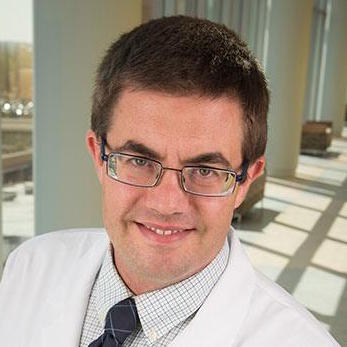Research and treatment of head and neck cancers at the University of Colorado Cancer Center reached a new level this month with a highly competitive Specialized Programs of Research Excellence (SPORE) grant from the National Cancer Institute (NCI). The SPORE was approved by NCI Scientific Program leadership for FY2021 funding; the projected starting date is July 1.
SPOREs at institutions around the country focus on either a specific organ site, such as breast or lung cancer, or on a group of highly related cancers, such as head and neck cancers, which include laryngeal (voice box) and hypopharyngeal (lower throat) cancer; oral cavity (tongue and gums) and oropharyngeal (tonsil and back of the tongue) cancer; nasopharyngeal (upper throat behind the nose) cancer; nasal cavity and sinus cancer; thyroid cancer; and salivary gland cancer. SPOREs are designed to enable the rapid and efficient movement of basic scientific findings into clinical settings, as well as to determine the biological basis for observations made in individuals with cancer or in populations at risk for cancer. Currently, there are three other head and neck cancer SPOREs in the U.S. This will be the only SPORE at the CU Cancer Center, however, the center is hoping to expand designation into other SPOREs in the upcoming years.
An increasingly common problem to solve
SPORE co-leader and CU Cancer Center Developmental Therapeutics Program Co-Leader Antonio Jimeno, MD, PhD, says head and neck cancer has seen a 70% increase in the U.S. over the past decade. “In 2005 there were 39,000 cases, in 2015 around 66,000 cases, and in 2020, the estimates are that there were 72,000 cases,” he says. “The NCI recognizes that. This is very important, because there are a lot more patients than there used to be, and many of them are younger than ever.”
The increase is attributed to a shift in tobacco use from cigarettes to chewing tobacco and cigars, as well as a rise in cases linked to the human papillomavirus (HPV), which is a primary cause of around 30,000 head and neck cancer cases per year.
“The SPORE is unique because every single project has to have a so-called ‘human endpoint,’” says SPORE co-leader and CU Cancer Center member XJ Wang, MD, PhD. “That means you have to directly impact patients. The SPORE will directly impact our cancer patient population in real time.” Jimeno adds that the grant will be very important to patients in Colorado because it is going to enable access to and initiation of clinical trials that otherwise would not happen.
Team science grant with multiple components
The NCI grant is for $2 million per year for five years. “The SPORE program has been in the making for over 10 years, serving as a scientific incubator and pipeline,” Wang says, adding that “we have engaged a coalition of supporting parties, including the CU School of Medicine, School of Dental Medicine, the CU Cancer Center, UCHealth, academic units under these organizations, and multiple philanthropic donors who have contributed direct funds and endowed chairs.” These funds were used to develop promising projects.
“A very strong team of collaborators have helped us propel this into a successful collaborative science grant, and along the way generated well over $10 million in other funding, including seven R01 grants that resulted from the SPORE development over the last few years,” Jimeno says. “This is teamwork at its best.”
“We have received a significant pledge for supplementary institutional support that will bring up the total direct activity of this grant close to $15 million, but the ripple effect will likely be much larger as this will spur additional research and trial activity in this key area and helps us attract and recruit talent nationwide,” Jimeno adds. “For us, the work begins now. We need to make sure we’re not only successful conducting the research we have proposed, but that we start developing a pipeline of projects and promising young investigators so that we can grow into what we can be, which is the best head and neck cancer program in the country.”
CU Cancer Center director Richard Schulick, MD, MBA, says the SPORE is the result of years of hard work by CU Cancer Center researchers.
“Drs. Jimeno and Wang, along with other leaders, have been working to build our research team in head and neck cancer for more than a decade now,” he says. “They already have secured an impressive amount of independent funding, and the SPORE designation will only help to solidify our strengths and reputation in this important area.”
Structure of the SPORE
The head and neck SPORE has a total of 46 directly involved researchers (26 key and 20 non-key by NCI definition), as well as patient advocates and internal and external advisor panels. It will center around three research projects and two programs, the Career Enhancement Program (CEP) and Research Development Program (DRP). All will be supported by specifically designed “cores”: pathology, data sciences, and administration.

Project 1 will study novel immunotherapy mechanisms driven by the EphB4 pathway and how these interactions between immune and vascular cells drive head and neck cancer. Co-leaders are Sana Karam, MD, PhD, and Lynn Heasley, PhD; co-investigators include Rachel Friedman, PhD, Julie Goddard, MD, and Jessica McDermott, MD.
Project 2 will test if dual inhibition of two key pathways (TGFb and PD-L1) combined with radiation therapy (RT) induces in situ vaccination and reverses immune suppression. It is co-led by XJ Wang and Daniel Bowles, MD; co-investigators are Karam, Jing Wang, PhD, and Christian Young, PhD.
Project 3 will study SVC112, a novel drug that inhibits protein elongation in the ribosomes, a drug discovered in Colorado by co-leader Tin Tin Su, PhD. It will use immune relevant models including humanized mice to study immune mechanisms. It is co-led by Jimeno, with Stephen Keysar, PhD, John Morton, PhD, and Jing Wang among the co-investigators.
The CEP has the key role of identifying and nurturing new head and neck cancer investigators, and is co-led by Raphael Nemenoff, PhD, and Daniel Bowles, MD. The DRP will select and support new pilot projects and is co-led by Mary Reyland, PhD, and Bryan Haugen, MD.
The three cores supporting the research projects are the Tissue Banking Core, co-directed by Scott Lucia, MD, and Adriaan Van Bokhoven, PhD, with Von Samedi, MD, PhD, as co-investigator; the Data Science Core, directed by Dexiang Gao, MS, PhD, with James Costello, PhD, as co-investigator; and the Administrative Core, co-directed by Jimeno and Wang, with Pamela Garl, MS, MBA, as program administrator.





.png)